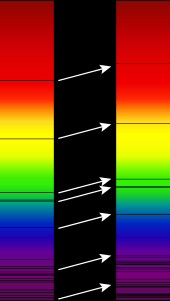Hubble's law
observation in physical cosmology From Wikipedia, the free encyclopedia
Hubble's law, or the Hubble–Lemaître law, is the name for an astronomical observation. The observation is that:
- All objects observed in deep space have a doppler shift-measured velocity relative to Earth, and to each other;
- That velocity is proportional to their distance from the Earth and all other interstellar bodies.

The space-time volume of the observable universe is expanding. Hubble's law is the direct physical observation of this.[1] This is why we believe the Universe is expanding. The evidence supports the Big Bang model.
Although widely attributed to Edwin Hubble, the law was first derived from the General Relativity equations by Georges Lemaître in a 1927 article. There he proposed that the Universe is expanding, and suggested a value for the rate of expansion, now called the Hubble constant.[2][3][4][5][6] Two years later Edwin Hubble confirmed the existence of that law and got a more accurate value for the constant that now bears his name.[7] The recession velocity of the objects was inferred from their redshifts, as measured earlier by Vesto Slipher in 1917 and related to velocity by him.[8]
Expression
The law is often expressed by the equation v = H0D, with H0 the constant of proportionality (the Hubble constant) between the "proper distance" D to a galaxy and its velocity v (see Uses of the proper distance). H0 is usually quoted in (km/s)/Mpc, which gives the speed in km/s of a galaxy 1 megaparsec (3.09×1019 km) away. The reciprocal of H0 is the Hubble time.
Estimation
A recent 2011 estimate of the Hubble constant, which used a new infrared camera on the Hubble Space Telescope (HST) to measure the distance and redshift for a collection of astronomical objects, gives a value of H0 = 73.8 ± 2.4 (km/s)/Mpc.[9][10] An alternate approach using data from galactic clusters gave a value of H0 = 67.0 ± 3.2 (km/s)/Mpc.[11][12]
A number of other methods have been used, giving figures between 70 and 72 (km/s)/Mpc. A recent (2016) method using the oldest light in the universe suggests the Hubble Constant value was 66.53km/s per megaparsec soon after the expansion began. This implies that the rate of expansion has been increasing.[13]
Rate of expansion
The expansion of the Universe is accelerating.[14][15][16] The accelerated expansion of the universe was discovered during 1998 by two independent projects. These were the Supernova Cosmology Project and the High-Z Supernova Search Team. They both used distant type 1a supernovae to measure the acceleration.[17][18][19]
More recent accounts
According to an article in New Scientist, there are two main ways of measuring this, and they do not agree.[20] The two methods used are:
Related pages
References
Wikiwand - on
Seamless Wikipedia browsing. On steroids.
